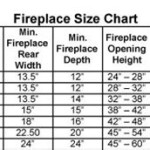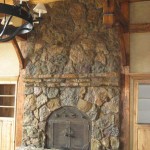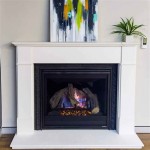Painting a brick fireplace white is a common home renovation project undertaken to brighten up a living space and modernize the overall aesthetic. It's a cost-effective way to transform a dated or dark fireplace into a focal point that complements various interior design styles. However, before embarking on this project, it's crucial to understand the necessary preparation, the appropriate materials, and the proper painting techniques to ensure a long-lasting and visually appealing result.
Assessing the Condition of the Brick
The first step involves thoroughly inspecting the brick fireplace. Look for any signs of damage, such as cracks, loose mortar, or efflorescence. Efflorescence is a white, powdery deposit on the surface of the brick, caused by salt deposits rising to the surface. Addressing these issues before painting is critical for the longevity of the paint job. Cracks and loose mortar should be repaired with appropriate patching compounds designed for masonry. Efflorescence needs to be removed using a wire brush or a specialized efflorescence cleaner, followed by thorough rinsing and drying.
Additionally, evaluate the existing surface treatment of the brick. Has it been previously painted, sealed, or treated with any protective coatings? Understanding the existing surface is essential for proper preparation and paint adhesion. Previous paint layers may need to be sanded or stripped, while sealants might require a bonding primer to ensure the new paint adheres correctly. Failure to address these pre-existing conditions can lead to peeling, chipping, and ultimately, a less than satisfactory outcome.
Consider the type of brick as well. Some brick is more porous than others, which will affect the amount of paint required for adequate coverage. Porous brick will absorb more paint, potentially requiring multiple coats. Identifying the brick type early on allows for a more accurate estimation of material needs and helps prevent unexpected surprises during the painting process.
Preparation is Paramount
Proper preparation is arguably the most crucial aspect of painting a brick fireplace. Thorough cleaning is the foundation for a successful paint job. Start by removing any loose debris, dust, and cobwebs with a vacuum cleaner and a stiff brush. Then, wash the brick surface with a solution of trisodium phosphate (TSP) and water, following the manufacturer's instructions carefully. TSP is a powerful degreaser that effectively removes dirt, grime, and soot, ensuring proper paint adhesion. Rinse the brick thoroughly with clean water and allow it to dry completely before proceeding. This drying process can take several days, depending on the humidity levels.
Once the brick is clean and dry, protect the surrounding areas. Use painter's tape to mask off the walls, mantel, hearth, and any other surfaces you don't want to be painted. Cover the floor with drop cloths or plastic sheeting to protect it from paint splatters. Taking the time to properly mask and protect these areas will save significant time and effort in cleaning up later.
Priming is an essential step, especially if the brick is porous or has been previously treated. A high-quality masonry primer will seal the brick surface, create a uniform base for the paint, and improve adhesion. Choose a primer specifically designed for masonry and follow the manufacturer's instructions for application. Apply the primer evenly, ensuring all cracks and crevices are covered. Allow the primer to dry completely before applying the paint. Skipping the priming step can result in uneven paint coverage, poor adhesion, and ultimately, a shorter lifespan for the paint job.
Choosing the Right Paint and Application Techniques
Selecting the correct type of paint is crucial for achieving a durable and visually appealing finish. Latex paint is generally recommended for painting brick fireplaces due to its flexibility, breathability, and resistance to cracking and peeling. Opt for a paint with a matte or satin finish for a more modern and sophisticated look. Avoid using glossy paints, as they tend to highlight imperfections in the brick surface.
Consider using a paint specifically formulated for masonry. These paints are designed to withstand the unique challenges of brick surfaces, such as moisture and temperature fluctuations. They often contain additives that enhance adhesion, prevent efflorescence, and protect against mildew growth. Investing in a high-quality masonry paint will contribute to a longer-lasting and more visually appealing result.
When it comes to application, use a combination of brushes and rollers to ensure thorough coverage. A brush is ideal for reaching into the mortar joints and crevices, while a roller is more efficient for covering the flat surfaces of the brick. Apply the paint in thin, even coats, allowing each coat to dry completely before applying the next. Multiple thin coats are preferable to one thick coat, as they prevent drips, runs, and uneven coverage.
Start by using a brush to "cut in" around the edges of the fireplace, carefully painting the mortar joints and any hard-to-reach areas. Then, use a roller to apply the paint to the flat surfaces of the brick, working in a consistent direction. Overlap each roller stroke slightly to ensure complete coverage. Allow the first coat of paint to dry completely, as recommended by the manufacturer. Then, inspect the surface for any missed spots or areas that require additional coverage. Apply a second coat of paint, following the same techniques as before. Two coats are typically sufficient for achieving a uniform and durable finish.
Consider the ventilation of the area while painting. Ensure adequate airflow to facilitate drying and prevent the buildup of fumes. Open windows and doors, and use fans to circulate the air. If necessary, wear a respirator to protect yourself from paint fumes.
After completing the painting, carefully remove the painter's tape while the paint is still slightly wet. This will prevent the paint from peeling or chipping along the edges. Touch up any areas where the paint has bled under the tape. Allow the paint to dry completely before placing any decorative items on the mantel or hearth. Following these application techniques will contribute to a professional-looking and long-lasting paint job.
Maintaining the painted brick fireplace is relatively straightforward. Regularly dust the surface with a soft cloth to remove any accumulated dust or debris. Clean any spills or stains promptly with a mild detergent and water. Avoid using harsh cleaning chemicals or abrasive scrubbers, as they can damage the paint finish. Inspect the painted surface periodically for any signs of peeling, chipping, or cracking. Address any issues promptly to prevent them from worsening. With proper care and maintenance, a painted brick fireplace can retain its beauty and functionality for many years to come.

Painting Brick Fireplace White A Renovation Story

How To Paint A Brick Fireplace What Use Home With Janny

How To Paint A Brick Fireplace

How To Paint Your Fireplace Brick Surround

How To Paint Your Brick Fireplace Katie Lamb

How To Prep Prime And Paint A Brick Fireplace Young House Love

How To Paint A Brick Fireplace

Painting Our Brick Fireplace White Emily A Clark

White Painted Brick Fireplace Makeover Jennifer Rizzo

7 Beautiful Ideas For Painting Interior Brick Fireplaces








